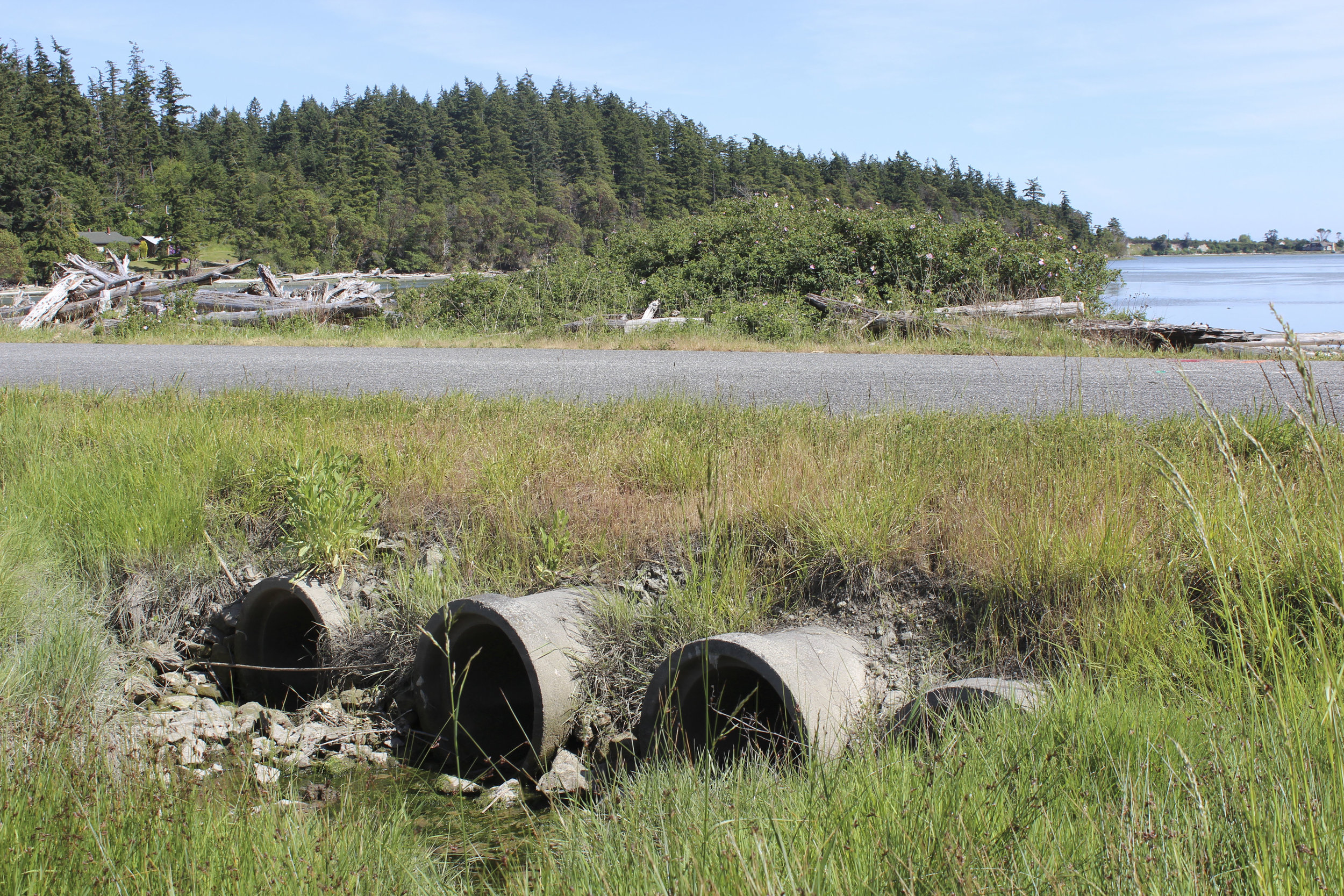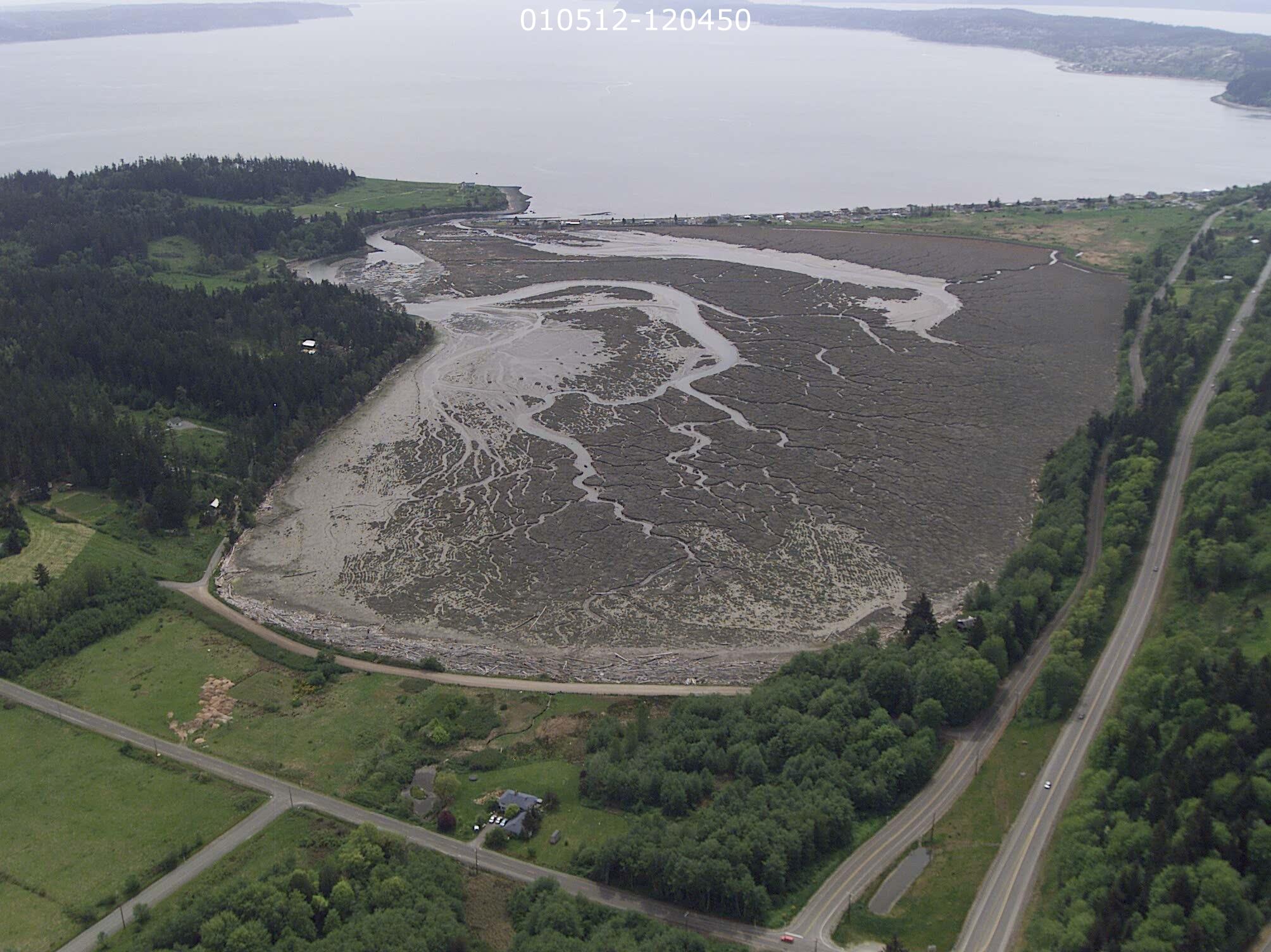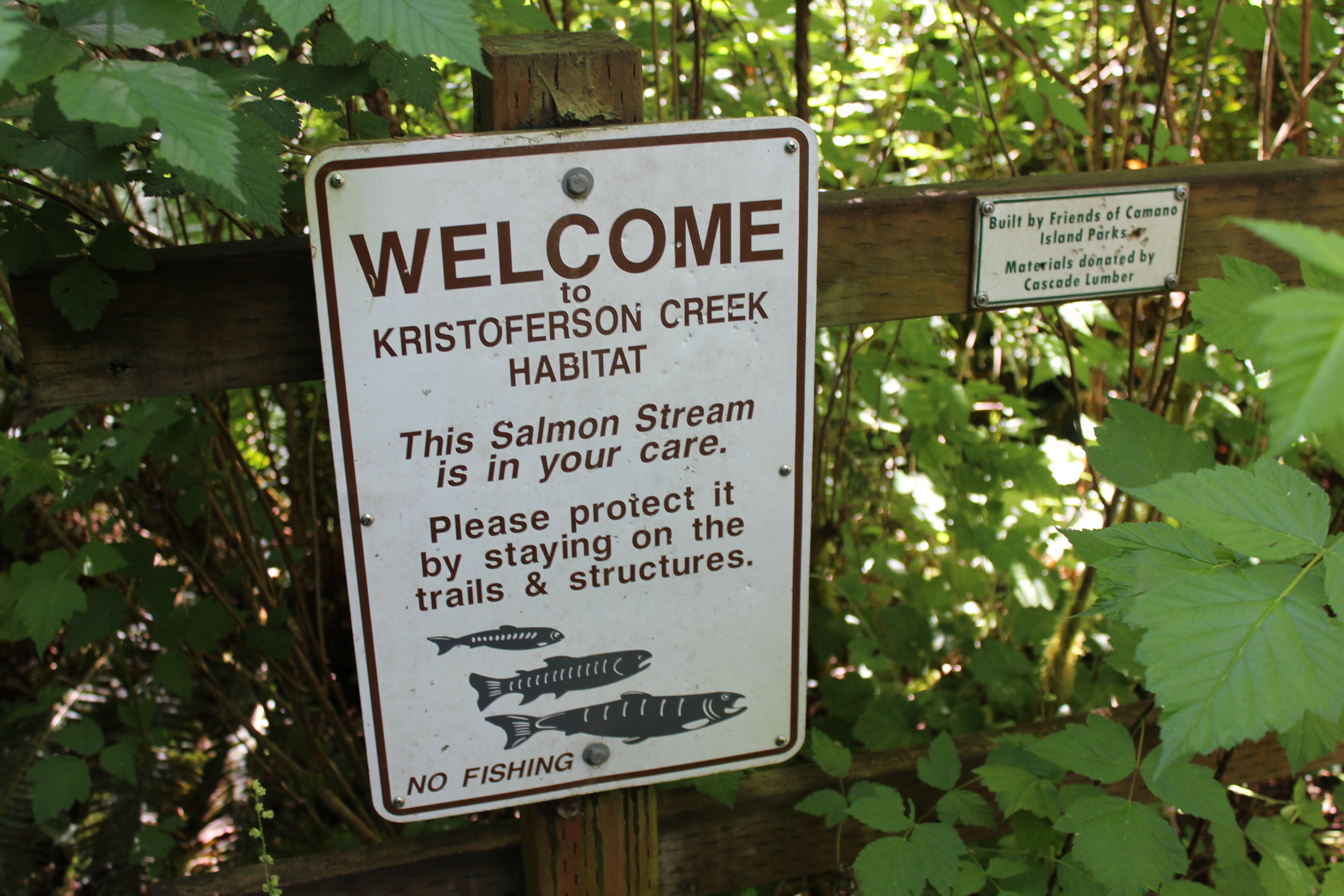Kristoferson Fish Passage Project Nearing Completion
/Patience is a virtue as they say. And, here at Snohomish Conservation District (SCD), we practice that skill every day. We can have staff leave and return years later before projects are completed. The Kristoferson Creek fish passage is one of those projects. SCD is partnering with Island County Public Works to replace the Kristoferson Creek culverts at Barnum and Russell Roads, the lowest barriers in the stream, to allow threatened Chinook salmon, steelhead and other fish to move easily between the important habitats in Triangle Cove and Kristoferson Creek.
The Beginning
First initiated at SCD in 2007 by Habitat Restoration Specialist Jenny Baker (now at The Nature Conservancy), this fish passage project is now on track to be completed at the end of the summer of 2018. In addition to Jenny, District Engineer Ryan Bartelheimer, during his first stint with SCD, provided a conceptual design for this project in May of 2008. He left the District in 2009 and returned the summer of 2018.
In chatting with Ryan, he was able to dig through his archives to find a fish passage barrier assessment completed by the Adopt A Stream Foundation in 2007, his preliminary design, and a construction cost estimate of about $65,000 for the lower stream crossing. Back then they identified that three of the four culverts beneath Barnum Road were “slope barriers,” not of an adequate size, and did not retain any streambed material (fish prefer to swim over stream gravel and cobble rather than the smooth bottoms of culvert pipes). The culvert at Russell Road was also too small, too steep, and did not retain any streambed material.
While these road crossings have been identified as partial barriers to fish migration for over a decade and multiple agencies, organizations, and Camano residents and volunteers have attempted to replace these barriers, the fact remains that juvenile and adult fish are unable to freely pass these barriers. It is likely that fish have only been able to pass through the lower culverts at the mouth of Kristoferson Creek on a flood tide, when the water is still or flowing upstream; the upstream culvert similarly poses challenges to adult fish swimming upstream to spawning habitat. In spite of these obstacles, there are a few fish that do make it into in Kristoferson Creek!
In 2008, the Tulalip Tribes, with support from a Camano local powerhouse volunteer and salmon champion, Barbara Brock, sampled the stream and found 28 coho smolts, 2 rainbow trout, and 2 juvenile bluegill and chum. Barbara remains involved in salmon recovery to this day and serves as co-chair of the Salmon Recovery Technical and Citizen Committee (SRTCC).
Even though they found fish, fundraising was an issue and the project didn’t go anywhere.
However, time passed, and in 2012 there was another fish survey completed by Tulalip Tribes and the Skagit River System Cooperative that documented two endangered fish species using lower Kristoferson Creek: young Chinook salmon and steelhead from the Stillaguamish, Snohomish, and Skagit Rivers. The fish were found using the stream as a nursery on their trip through the freshwater streams and rivers where they hatched, out to Port Susan, and then out to the Pacific Ocean. Both species are prioritized for habitat restoration actions as they are listed as Threatened under the Endangered Species Act, and fixing the fish passage barriers on lower Kristoferson Creek were once again viewed as an important project for salmon recovery.
“Puget Sound Chinook salmon populations were listed as threatened under the Endangered Species Act (ESA) in 1999. This led biologists and natural resource managers to ask questions related to what changes need to occur and to develop plans to recover wild Chinook salmon populations in Puget Sound.”
- From the report published December 3, 2013 - http://skagitcoop.org/wp-content/uploads/EB2752_Beamer-et-al_2013.pdf
On this map below, Kristoferson Creek is #25 and the study investigators did find juvenile Chinook and steelhead:
The Why
Why are these small streams, once thought too small to support Chinook salmon and many other salmon species, important? In addition to providing a safe and food-rich stop for young fish leaving freshwater rivers and migrating out to the ocean, these small streams and their associated estuaries may provide other benefits.According to the study, “Because fry migrant juvenile Chinook salmon are leaving the saline waters of the Whidbey Basin and entering these small streams, it may be true that the freshwater input serves to attract fish into the stream. It is likely that the fresh water in the stream serves an important function – osmoregulation – and that these independent small coastal streams could be considered a physiological refuge for juvenile Chinook salmon (as suggested by Redmond et al. 2005 - links below). Regardless, juvenile Chinook salmon are staying in the small streams long enough, and for other activities such as foraging, for the streams to be considered important.”
(Sources: Skagit River System Cooperative & Washington Department of Fish and Wildlife. 2005. Skagit Chinook Recovery Plan. Available at www.sharedsalmonstrategy.org/ or www.skagitcoop.org/.)
Dawn Pucci, Lead Entity Coordinator for Island County, said that, "This study was one of the first to recognize the importance of small coastal streams for Chinook salmon." In 2013-2014, it was suggested that Barnum Road should be abandoned, which was actually the second time that Barnum Road abandonment was discussed as an option for restoring fish access and estuary habitat at Triangle Cove and Kristoferson Creek. That idea was not received well in either 2007-08 or in 2015-2017, she said.
From Lori Clark, MS, RS, Island County Department of Natural Resources Manager:
“The Island Local Integrating Organization prioritization process helped Island County get clear about what actions we needed to focus on locally to make the biggest impact on ecosystem recovery in Puget Sound. In 2012 we identified barrier culverts as one of the priority pressures on Chinook Salmon locally and we developed a list of priority near-term actions for the 2014 Action Agenda, which included removing fish-passage barriers. Prioritizing the retrofitting of culverts as a recovery action helped gain political support locally and was the catalyst for developing a work plan for removing fish passage barriers in priority watersheds and securing funding to implement these projects. Kristoferson Creek was the focus for the first fish passage barrier removal project because of its proximity to the Skagit, Stillaguamish, and Snohomish Rivers and because it is one of the three known streams with Chinook salmon presence in Island County.”
There were still hurdles to clear, however, in the effort to replace these barriers. Ultimately, it came down to money. In 2014 there wasn’t enough and the project wasn’t high enough ranked. In 2015, that sentiment changed: SCD re-scoped the project to get more bang for one’s buck by replacing two barrier crossings - Barnum Road and Russell Road - and get 0.81 miles of fish passage at the same time. SCD also secured several matching grants for the project. Finally, there was forward motion.
Now by then, the new lead on the project at SCD became current Senior Habitat Specialist, Kristin Marshall.
Kristin has been working diligently with funders, Island County, the contractor (local to Camano Island, Konnerup Construction Inc.), and the Washington Department of Fish and Wildlife to complete this project by the end of this summer.
Keeping the Project Going
In between 2007 and 2018 when Island County, SCD, and local Camano resident volunteers have been working to replace the barriers at the downstream end of Kristoferson Creek, a local family and business have been busy fixing the fish passage barrier culverts on their farm and forest property on their own. The family at Kristoferson Farm replaced additional culverts and bridges at the top of the hill at their farm, and completed riparian buffers, too. Mona K. Campbell shared that they were “Happy to help!” This highly visible farm, which the family has owned and managed since 1912, is an asset to the community of Camano Island, and the work that the Kristoferson family has undertaken over the past 7-plus years shows their dedication to restoring and protecting wildlife habitat while responsibly using natural resources.
Once these two additional culverts are replaced, there will be a total of 0.81 miles of new passable waterway for juvenile Chinook salmon and steelhead and other salmon species. All that remains for fish to have a free path between the estuary and the entire 1.65 miles of Kristoferson Creek is one final culvert.
The last barrier on the stream is a culvert owned by Island County at East Camano Drive. The County has begun applying for grants and developing early designs to replace this final barrier.
It takes a village of caring people and long-term diligence to make these projects happen and see them to fruition.
Juvenile salmon need to have a place to grow up. Estuaries, creeks, and streams act as nurseries for young fish. If the water flows too fast or is not deep enough, or there are huge leaps in height, the young fish are unable to use the waterway to forage and grow strong enough to survive in the ocean. Replacing the culverts near the mouth of Kristoferson Creek with fish-friendly culverts will give the young fish coming from nearby rivers the sanctuary and food they need to grow into and thrive as adults.
Funding for this project has been provided by the Washington State Salmon Recovery Funding Board (Recreation and Conservation Office), the Puget Sound Partnership and Island County Local Integrating Organization, the Washington State Conservation Commission, and the United States Fish and Wildlife Service.
Public Meeting Scheduled
Please join us on Thursday, August 9th at the Camano Library from 6:00 p.m. to 7:30 p.m. to learn more about the project, timeline and construction impacts including traffic detours this summer.
Do you have questions or comments about the Kristoferson Creek fish passage project?
Call or email Kristin Marshall, project manager, at 425-377-7017, kristin@snohomishcd.org.
Would you like to receive project and construction updates by email?
Sign up at snocd.org/kristoferson-creek
Do you have any comments you want to share about this project?
Share them at snocd.org/kristoferson_comments
Learn More about Island County's Work:
https://www.islandcountywa.gov/Health/DNR/Salmon/Pages/Home.aspx






